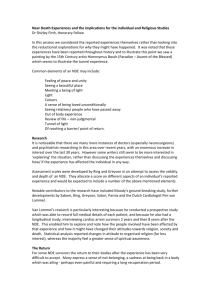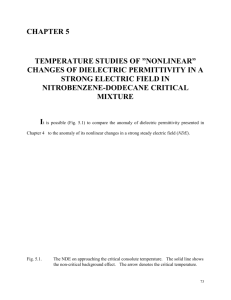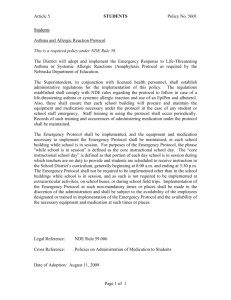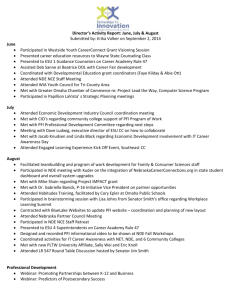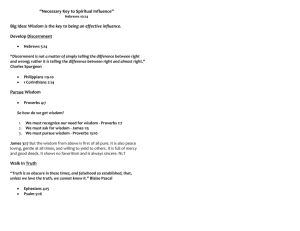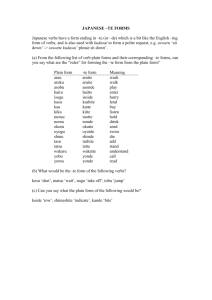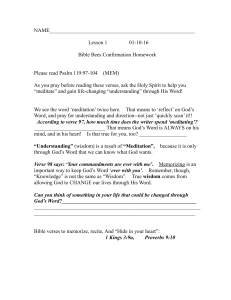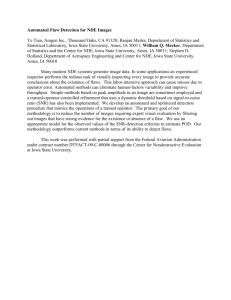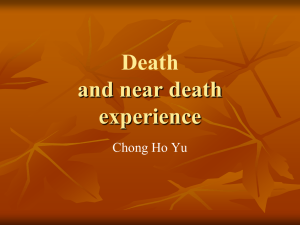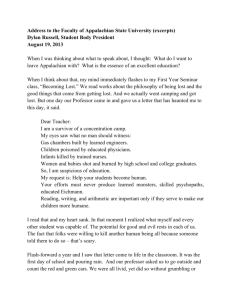the near-death experience and the perennial wisdom
advertisement
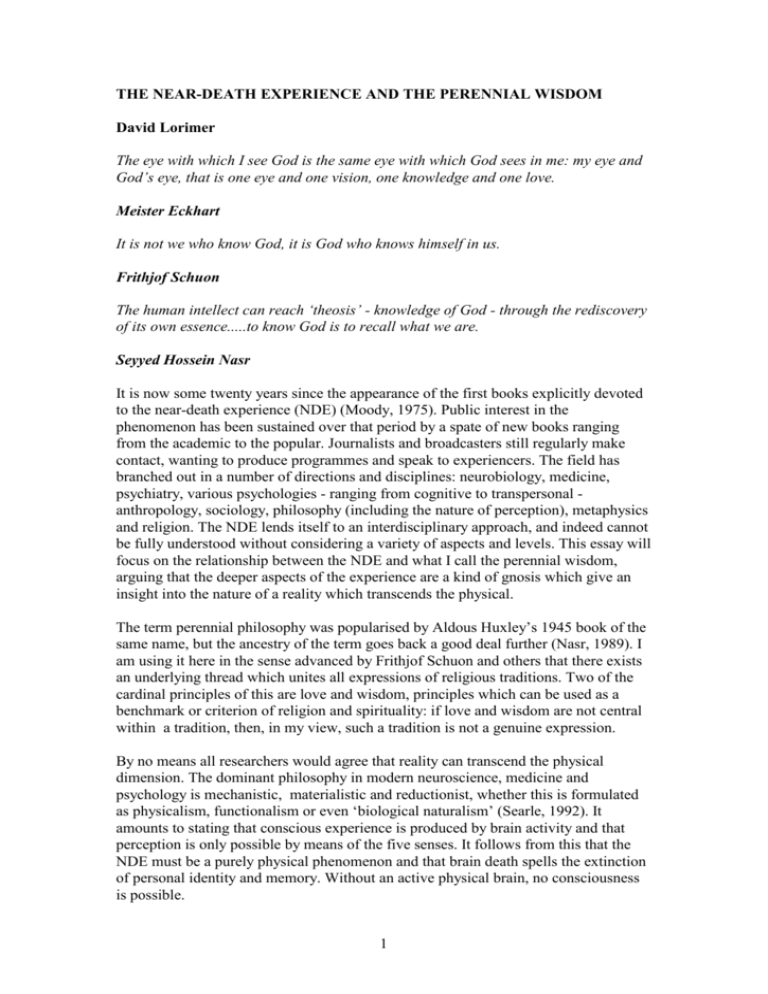
THE NEAR-DEATH EXPERIENCE AND THE PERENNIAL WISDOM David Lorimer The eye with which I see God is the same eye with which God sees in me: my eye and God’s eye, that is one eye and one vision, one knowledge and one love. Meister Eckhart It is not we who know God, it is God who knows himself in us. Frithjof Schuon The human intellect can reach ‘theosis’ - knowledge of God - through the rediscovery of its own essence.....to know God is to recall what we are. Seyyed Hossein Nasr It is now some twenty years since the appearance of the first books explicitly devoted to the near-death experience (NDE) (Moody, 1975). Public interest in the phenomenon has been sustained over that period by a spate of new books ranging from the academic to the popular. Journalists and broadcasters still regularly make contact, wanting to produce programmes and speak to experiencers. The field has branched out in a number of directions and disciplines: neurobiology, medicine, psychiatry, various psychologies - ranging from cognitive to transpersonal anthropology, sociology, philosophy (including the nature of perception), metaphysics and religion. The NDE lends itself to an interdisciplinary approach, and indeed cannot be fully understood without considering a variety of aspects and levels. This essay will focus on the relationship between the NDE and what I call the perennial wisdom, arguing that the deeper aspects of the experience are a kind of gnosis which give an insight into the nature of a reality which transcends the physical. The term perennial philosophy was popularised by Aldous Huxley’s 1945 book of the same name, but the ancestry of the term goes back a good deal further (Nasr, 1989). I am using it here in the sense advanced by Frithjof Schuon and others that there exists an underlying thread which unites all expressions of religious traditions. Two of the cardinal principles of this are love and wisdom, principles which can be used as a benchmark or criterion of religion and spirituality: if love and wisdom are not central within a tradition, then, in my view, such a tradition is not a genuine expression. By no means all researchers would agree that reality can transcend the physical dimension. The dominant philosophy in modern neuroscience, medicine and psychology is mechanistic, materialistic and reductionist, whether this is formulated as physicalism, functionalism or even ‘biological naturalism’ (Searle, 1992). It amounts to stating that conscious experience is produced by brain activity and that perception is only possible by means of the five senses. It follows from this that the NDE must be a purely physical phenomenon and that brain death spells the extinction of personal identity and memory. Without an active physical brain, no consciousness is possible. 1 An alternative view postulates that consciousness is not so much produced by as transmitted through the brain (James, 1899, Schiller, 1891, Lorimer, 1984). Thus conscious states would be correlated with rather than caused by brain activity. The distinction is a crucial one, since it allows the possibility that the mind or soul might operate independently of the physical brain and have access to non-physical aspects or dimensions of reality. Furthermore, the death of the brain need not necessarily spell the extinction of the individual, but possibly a transformation or shift to a different state of consciousness. In this view, the brain could be regarded as the space-time limitation or localisation of consciousness, which itself is not intrinsically limited or localised. This theory is capable of accounting for the kind of out-of-the-body perception reported in NDEs, while the brain-based approaches are obliged to ignore or dismiss such evidence. The fundamental issue here is this: is the physical world a closed self-sufficient system so that everything can be causally explained in physical terms? Or does it open into inner dimensions which transcend the physical realm? The modern scientific world-view assumes the former position, while all types of spiritual world-view insist that there is something more. The quotations at the top of this essay make very little sense to those who do not believe that there is a God to discover or know. Yet throughout history (Zaleski, 1986) there have been reports of ‘otherworld journeys’ from those who have come back from the borderland of death. One of the earliest analogies to the traveller’s tale is Plato’s simile of the cave in the Republic (Lee, 1974). The prisoners in the cave take the shadows thrown by the fire on the wall opposite as reality, and are reluctant to believe in the existence of anything else. Yet, as Plato argues, there are many other degrees of reality which are more real than what can be perceived inside the cave. There is a gradual ascent from illusion through belief, reason (dianoia) and intelligence (nous) to a ‘vision of the form of the good’ represented by looking at the sun. It is here that Plato’s symbolism begins to meet the phenomenology of the NDE. The stages described seem to indicate a gradual withdrawal from the physical realm and entry into another, spiritual realm which is always sensed as more real than the physical on the traveller’s return. An interesting reflection on this point is provided by ‘Bertrand Russell’, ostensibly communicating through medium Rosemary Brown (Brown, 1974). Now here I was, still the same I, with capacities to think and observe sharpened to an incredible degree. I felt earth-life suddenly seemed very unreal almost as if it had never happened. It took me quite a long time to understand this feeling until I realised at last that matter is certainly illusory although it does exist in actuality; the material world seemed now nothing more than a seething, changing, restless sea of indeterminable density and volume. How could I have thought that that was reality, the last word of Creation to Mankind? Yet it is completely understandable that the state in which a man exists, however temporary, constitutes the passing reality which is no longer reality when it has passed. ‘Russell’s’ remark that his capacities to think and observe were sharpened to an incredible degree is typical of the NDE and flies in the face of the materialistic assumption that a dying brain could only result in confused perceptual processes. The evidence for this comes from reports of veridical OBEs during the NDE, where 2 subjects are able to give an accurate report of events going on around them when they were apparently completely unconscious. In one Dutch case, a man was brought into hospital following a heart failure and subsequently transferred to intensive care without recovering consciousness. Ten days later he was brought back to the ward. Not only did he recognise the nurse (whom he had never seen before) as having been present at his resuscitation, which he described in detail, but he even asked her where she had put his false teeth! The subject had seen her place them in a glass of water. The nurse was flabbergasted, as there was no normal way in which the subject could have known this. Sceptics argue that such reports could have been reconstructed from residual hearing, but such an interpretation does scant justice to the detailed visual nature of the experience and the fact that many actions or phenomena reported were not actually verbalised by the medical staff. This stage of the NDE is the first point of contact with the perennial wisdom, which speaks of subtle bodies or vehicles of consciousness beyond the physical form or envelope. The subjects realise that they are more than their physical body, and sometimes even hear themselves pronounced dead in spite of the fact that they are still conscious and often looking down on the scene from above. The next stage of ‘going through the tunnel’ almost sounds like emerging from the Platonic cave into the light. The ‘light’ is described as very bright, but harmless to the eyes. It is clearly not physical light, but rather spiritual light, a distinction which has its counterpart in Latin (lumen/lux) and Bulgarian (videlina/svetlina). Light has from time immemorial been the symbol of the Divine, but, as Eckhart indicates in the quotation above, this light is also knowledge and love. Experiencers write (Lorimer, 1990): I found myself travelling towards this tremendous light, so bright that it would have blinded me if I’d looked at it here, but there it was different. I reached the light which was all around me...and I felt this wonderful love enfolding me and understanding me. No matter what my faults, what I’d done or hadn’t done, the light loved me unconditionally. Again: A light was glowing invitingly - I was encouraged by a strong feeling to enter the light. I approached without haste as I felt that the light was part of the jigsaw to which I rightfully belonged. As I entered, I felt the light glow. I was peaceful, totally content and I understood why I was born on earth and knew the answer to every mystery. These two accounts show that the light has both cognitive or intellectual and affective or emotional aspects. In terms of the perennial philosophy this can be translated into wisdom and love respectively. It is significant that the root of the Latin word for wisdom - sapientia - comes from sapere, which means to taste. Wisdom, therefore, is derived from experience, and the NDE, in this sense, could be regarded as a taste of love and wisdom. This experience in turn influences the documented after-effects of the experience. Melvin Morse (Morse, 1992) even goes on to argue that the transformative effects of the NDE are due to the light, a hypothesis consistent with other research in religious experience (Hardy, 1979) indicating transformation following spiritual encounters. 3 A central feature of the experience of the light is that it is unitive: there is a sense of complete oneness - at-onement - in which the sense of self is nevertheless retained and expanded at the same time. Plotinus writes that the infinite can only be grasped ‘by entering into a state in which you are your finite self no longer....when you cease to be finite and become one with the infinite’ The poet Tennyson similarly records: ‘All at once, out of the intensity of the consciousness of individuality, individuality itself seems to fade away into boundless being’. The the Zen scholar Suzuki suggests that satori is an expansion of the individual into the infinite. It is as if the normal boundaries of the limited and contracted and seemingly separate self are suddenly dissolved. It is perhaps this transcendence of the ego which produces a loss of the fear of death. Modern NDE accounts are typical of what is known in the West as absorptive mysticism, where the self is absorbed into a higher or deeper order of reality in which light, live, intensity and certainty all meet. Consider this classic account from Ruysbroeck (Lorimer, 1990): And all those men who are raised up above their created being into a God-seeing life are one with this Divine brightness. And they are that brightness itself, and they see, feel and find, even by means of this Divine Light, that, as regards their uncreated essence, they are that same onefold ground from which the brightness without limits shines forth in the Divine way, and which, according to the simplicity of the Essence, abides eternally onefold and wayless within. And this is why inward and God-seeing men will go out in the way of contemplation, above reason and above distinction and above their created being, through an eternal, intuitive gazing. By means of this inborn light they are transfigured, and made one with that same light through which they see and which they see. This last sentence recalls the circular paradox in the Eckhart quotation, only here Ruysbroeck refers to light rather than the eye. This change of perspective and perception is a form of gnosis whereby, as Schuon puts it, we ‘participate in the perspective of the Divine Subject’; And, in the words of Parmenides ‘to be and to know are one and the same thing’. This kind of knowledge itself represents a change of being which overcomes the division between subject and object. In the Indian tradition this state is the union of being, consciousness, bliss (Sat, Chit, Ananda). There is no separation between knower and known, only the knowing; none between the lover and the beloved, just the love. Such a union between love and knowledge is beautifully expressed by St. Maximus: ‘If the life of the spirit is the illumination of knowledge and if it is love of God which produces this illumination, then it is right to say: there is nothing higher than the love of God’. Seyyed Hossein Nasr makes the same point (Nasr, 1989): ‘This illumination in turn enables man to realise that the very essence of things is God’s knowledge of them and that there is a reciprocity and, finally, an identity between being and knowing. The intellect becomes transformed into what it knows, the highest object of that knowledge being God’. Such gnosis, according to both Nasr and Schuon, is through they eye of the heart, which is the eye of the intellect (nous) not reason (the two are often wrongly conflated - the intellect is whar enables us to grasp unity, while reason is dialectical and dualistic). The essence of the intellect, according to Schuon, is ‘light as well as vision, nor is it reason which is a reflection of intellect on the human plane, but it is the root and centre of consciousness and what has traditionally been called the soul’. 4 There is one further crucial feature of this gnosis: it is the truth which makes you free, the moksha or deliverance of Hinduism which is beyond form, beyond limitation and beyond ego. It is not just a concept, but a profound experience and, as Schuon says, ‘if we want truth to live in us, we must live in it’. The return from the light can be painful and disappointing as the subject wakes up again in limitations of the physical body. The NDE, though, leaves an indelible impression in most of the experiencers. It is as if they try to live out the values of love, wisdom, truth, joy, beauty and peace which have transfused their beings. Such a shift of attitude and perspective can create difficulties for close relationships where the partner remains unchanged. There tends to be a change from ‘having’ to ‘being’, that is away from purely material concerns and priorities. Subjects embark on a pursuit of wisdom and make love the central value of their lives. It is illuminating to compare the NDE and its accompanying transformation of values with the effects of conversion and initiation. William James (James, 1903) characterises conversion as a change in what he calls ‘the habitual centre of personal energy’, which precipitates ‘a mental rearrangement’ or reordering of priorities and values. The parallels with initiation are even more apparent, since one of its essential features is a ritual death and rebirth, a separation from the old and an embracing of the new (Eliade, 1958, Grosso, 1986). Grosso quotes an early Greek writer, Themistios, as stating that the soul has the same experience at the point of death as those who are being initiated: ‘First one is struck by a marvellous light, one is received into pure regions and meadows’. In this sense, experiencers of NDEs are unwitting initiates who have usually had no preparation whatsoever, in contrast with the careful instruction which preceded ancient initiation rituals. The poet Rumi writes: O man go die before thou diest So that thou shalt not have to suffer death when thou shalt die Such a death that thou wilst enter into light Not a death through which thou wilst enter into the grave In other words, a death leading to a new or second, spiritual birth. In speaking of patterns of initiation, Mircea Eliade (Eliade, 1958) remarks on the initiatory character of the ordeals and spiritual crises of life: ‘it remains true nonetheless that man becomes himself only after having solved a series of desperately difficult and even dangerous situations; that is after having undergone “tortures” and “death”, followed by an awakening to another life, qualitatively different because regenerated. If we look closely, we see that every human life is made up of a series of “deaths” and “resurrections”’. Eliade observes that such initiations are usually effective only at a psychological rather than ontological level, which I think is by and large true for NDEs although transformations can be so profound as to be clearly ontological - there is literally a change (or revelation) of being. Some people refer to the NDE as a ‘telephone call from God’, which acts as a reminder of their true nature. Plato’s myth of Lethe illustrates human forgetfulness of the nature of being and the purpose of human life. It is a spiritual awakening which 5 makes people conscious of their journey and responsibilities. Typically, the spirituality of experiencers is deepened and they experience a spiritual feeling of closeness to the Divine. The emphasis is therefore on the inner life more than on outer ritual and church attendance. Church goers find themselves taking a more mystical approach and become more concerned with an underlying universal core of religions what Schuon calls ‘the transcendent unity of religions’. They also enjoy spending more time alone and in Nature. In their search for the meaning of life and death, a significant number of NDE experiencers become interested, as I said, in more esoteric aspects of religion and spirituality. The lifework of Frithjof Schuon has been to formulate the transcendent unity of religions, showing that esoterism is the true form of ecumenism, not a watered down and compromised liberalism. The problems arise from the fact the Revelation is intrinsically absolute and extrinsically relative, in other words the essence is absolute and the form relative: ‘Religious revelation is both a veil of light and a light veiled’. Restrictive dogma arises when the form is taken to be equivalent to the essence. The esoteric aspects of a religion are its hidden inner essence only accessible through gnosis to those who have developed the appropriate organs of perception; while the exoteric aspects are the doctrines, dogmas and rituals in which the churchgoer is expected to believe implicitly and often unquestioningly. Schuon characterises the relationship between esoterism and exoterism as follows (Schuon, Nasr, 1986): ‘Esoterism on the one hand prolongs esoterism - by harmoniously plumbing its depth because the form expresses the essence and because in this respect the two enjoy solidarity, while on the other hand esoterism opposes exoterism - by transcending it abruptly - because essence by virtue of its unlimitedness is of necessity not reducible to form, or in other words, because form, inasmuch as it constitutes a limit, is opposed to whatever is totality and liberty’ He continues further on: We could say, simplifying a little, that exoterism puts the form - the credo - above the essence - Universal Truth - and accepts the latter only as a function of the former; the form, through its divine origin, is here the criterion of the essence. Esoterism, on the contrary, puts the essence above the form.....the essence is the criterion of the form; the one and universal Truth is the criterion of the various religious forms of the Truth....the particular or the limited is recognised as the manifestation of the principial and the transcendent, and this in its turn reveals itself as immanent. In contemporary terms, we have here the tension and conflict between the esoteric, universal and mystical approach and the exoteric, literalist, fundamentalist view. The fundamentalist pronounces his own revelation as absolute, exclusive and unique, so that anyone not accepting it on those terms is cast into outer darkness and forfeits salvation. The near-death experiencer will tend to express a more inclusive philosophy corresponding to the ineffability of the experience. Indeed one fundamentalist who had an NDE came back with the (to them) surprising thought that ‘God isn’t interested in theology’! Another experiencer tells of a presence which asked ‘What is in your heart?’ and added that what mattered most was the love expressed in one’s life; also that there is no such thing as sin, as humans commonly understand the term. 6 The emphasis throughout is on being rather than belief, and actions infused with spiritual qualities. A modern initiate and spiritual Master who was also an exponent of the perennial wisdom is the Bulgarian Beinsa Douno (Peter Deunov, 1864-1944). He taught in Bulgaria from 1900, and began giving systematic lectures in 1914. Between that time and his passing, he gave some 7,000 lectures and talks on every aspect of human existence. The cardinal principles of his Teaching, though, are simple: Love, Wisdom and Truth (Lorimer, 1991A) The first principle on which the whole of existence is based is Love; it brings the impulse to life; it is the compass, the stimulus within the human soul. The second principle is Wisdom, which brings knowledge and light to the mind, thus enabling human beings to use the forces of Nature in a noetic way. The third principle is Truth; it frees the human soul from bondage and encourages her to learn, work well and make efforts towards self-sacrifice. There is nothing greater than these three principles; there is no straighter or surer path. In these three principles lies the salvation of the world. These are the principles which we have already encountered in connection with the perennial philosophy and the NDE. They are expressed in practical form through the sacred dance movements of paneurythmy (Lorimer, 1991b). Douno echoes Schuon’s remarks about essence and form, but with a distinct emphasis: Love does not recognise any religion. It is Love itself which creates religions. In the Divine World there are no religions. There, only Love exists. Love is the very atmosphere of the Divine World. And everything in it breathes Love. Since Love cannot manifest on earth, there arose the need for religions. However, if you wish to fulfil the will of God, it is essential to substitute Love for religion. Religions are therefore the various forms and expressions of the Divine, and all have love or compassion at their core. The statement that Love is the very atmosphere of the Divine World expresses the experience in the NDE of being immersed in love and light (wisdom); and the centrality of the principle of Love in the NDE and its aftereffects unites it with the mystical and wisdom traditions in world religions. The success of two recent books on the NDE (Eadie, 1992, Brinkley, 1994) suggests to me that the spiritual content contains a message which resonates with many contemporary seekers. It comes directly out of an individual’s experience and yet contains universal elements which speak to our condition and yet point beyond it to the more profound and systematic teachings expressed in the perennial wisdom and outlined above. Some aspects of the NDE, then, can be seen as an opening into the transcendent realms beyond and within the apparently self-sufficient and closed physical system. It reveals to the experiencer hitherto unknown and little explored dimensions of the self, indicating that human beings are more than a physical body-mind. The experience can be regarded as a seed for spiritual growth in the perennial principles of Love, Wisdom 7 and Truth. Although these principles are universal, they are lived and experienced by individuals. Future forms of spirituality will, I believe, draw both on individual experience and timeless tradition, which remains a yardstick of its authenticity and sets in a broader and deeper context. References Brinkley, D. (1994) Saved by the Light. New York, Villard. Brown, Rosemary (1974). Immortals at my Elbow. London, Bachman and Turner. Eadie, B. (1992). Embraced by the Light. Placerville, CA, Goldleaf Press. Eliade, M. (1958). Rites and Symbols of Initiation. New York, Harper and Row. Grosso, M. (1986). The Final Choice. Walpole, NH, Stillpoint. Hardy, Sir A. (1979). The Spiritual Nature of Man. Oxford University Press. James, W. (1899). Human Immortality. London,Constable. James, W. (1903). The Varieties of Religious Experience. London, Longman. Lee, Sir H.D.P. (1974) Plato’s Republic. London, Penguin. Lorimer, D. (1984). Survival?. London, Routledge & Kegan Paul. Lorimer, D. (1990). Whole in One. London, Arkana. Lorimer, D. (1991a). Prophet for Our Times. Shaftesbury, Element. Lorimer, D. (1991b). The Circle of Sacred Dance. Shaftesbury, Element. Moody, R.A. (1975). Life after Life. New York, Mockingbird Books. Morse, M. (1992). Transformed by the Light. New York, Villard. Nasr, S.H. (ed) (1986). The Essential Writings of Fritjhof Schuon. Warwick, NY, Amity House Nasr, S.H. (1989). Knowledge and the Sacred. New York, SUNY. Schiller, F.C.S. (1891). Riddles of the Sphinx. London, Swan Sonnenschein. Searle, J.R. (1992). The Rediscovery of the Mind. Cambridge, MA., MIT Press. Zaleski, C. (1986). Otherworld Journeys. New York, Oxford. 8
